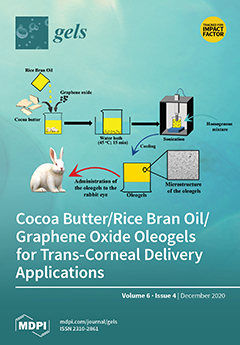Novel sodium carboxymethyl cellulose-
g-poly (sodium acrylate)/Ferric chloride (CMC-
g-PNaA/FeCl
3) nanoporous hydrogel beads were prepared based on the ionic cross-linking between CMC-
g-PNaA and FeCl
3. The structure of CMC and CMC-
g-PNaA were elucidated by
[...] Read more.
Novel sodium carboxymethyl cellulose-
g-poly (sodium acrylate)/Ferric chloride (CMC-
g-PNaA/FeCl
3) nanoporous hydrogel beads were prepared based on the ionic cross-linking between CMC-
g-PNaA and FeCl
3. The structure of CMC and CMC-
g-PNaA were elucidated by Fourier transform infrared spectroscopy (FTIR) and nuclear magnetic resonance (NMR) spectroscopy, and the elemental composition was analyzed by energy dispersive X-ray analysis (EDX). The physicochemical properties of the CMC-
g-PNaA/FeCl
3 hydrogel beads were analyzed by X-ray diffraction (XRD), scanning electron microscopy (SEM), atomic force microscopy (AFM) and thermogravimetric analysis (TGA). The swelling percentage of hydrogel beads was studied at different time periods. The obtained CMC-
g-PNaA/FeCl
3 hydrogel beads exhibited a higher nanoporous morphology than those of CMC-
g-PNaA and CMC beads. Furthermore, an AFM image of the CMC-
g-PNaA/FeCl
3 beads shows granule type topology. Compared to the CMC-
g-PNaA (189 °C), CMC-
g-PNaA/FeCl
3 hydrogel beads exhibited improvement in thermal stability (199 °C). Furthermore, CMC-
g-PNaA/FeCl
3 hydrogel beads depicted a higher swelling percentage capacity of around 1452%, as compared to CMC-
g-PNaA (1096%). Moreover, this strategy with preliminary results could be useful for the development of polysaccharide-based hybrid hydrogel beads for various potential applications.
Full article






